Having the heart of a parish priest and serving the Lord with gladness aptly describe Archbishop Mitchell Rozanski.
At his Mass of Installation Aug. 25 at the Cathedral Basilica of Saint Louis, Archbishop Rozanski told the people of the Archdiocese of St. Louis, “As a Catholic, even more as a pastor, I pledge my own fidelity, and unity and that of God’s people in this ‘Rome of the West’ to Peter’s successor among us, without whom we cannot know the Lord who sent him, the Lord who seeks to send us.”
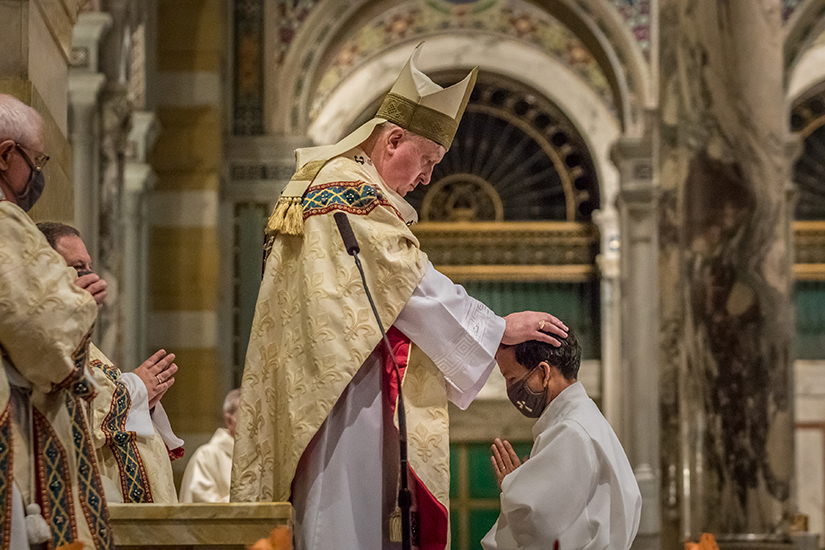 Archbishop Mitchell Rozanski ordained Deacon Jesus “Jesse” Gatmaitan to the permanent diaconate Aug. 29, just four days after Archbishop Rozanski was installed as Archbishop of St. Louis.Photo Credit: Lisa Johnston
Archbishop Mitchell Rozanski ordained Deacon Jesus “Jesse” Gatmaitan to the permanent diaconate Aug. 29, just four days after Archbishop Rozanski was installed as Archbishop of St. Louis.Photo Credit: Lisa JohnstonSt. Louis’ 10th archbishop served the Church in the Eastern United States for 36 years. Ordained a priest for the Archdiocese of Baltimore in 1984, he served in parishes for 20 years. He was ordained a bishop in 2004 and served as an auxiliary bishop in Baltimore for the next decade. He became the Bishop of Springfield, Massachusetts, in 2014
Being a parish priest brought its challenges and joys, but what was important was building relationships and maintaining communication with the people he served, he said. As a bishop, he sees himself still having the heart of a parish priest, but now his parish territory is a little bit larger.
“Parish priests are graced to be with people in such moments of their lives — weddings, baptisms, funerals — and that really establishes a relationship,” Archbishop Rozanski said. “I miss those relationships I had as a parish priest … but it’s also taught me that being a bishop does not mean being removed from that sort of interaction of ministry, of being involved in the lives of people and reaching out.”
Archbishop Rozanski’s episcopal motto, “Serve the Lord with Gladness,” comes from Psalm 100. He wanted something with an action word that would serve as a reminder of living the faith in concrete ways.
“If we do live our faith concretely in serving the Lord, then we will certainly have hearts that are joyful,” he said. “It means that if we put our faith into action, and we live the Lord’s words, then we’re joyful.”
The early inhabitants of St. Louis were a people of hope, who came to this area in search of a better life and a place to raise their families, he said. That kind of hope is needed in our world today. Citing urgent crosses facing our nation and Church today, including the COVID-19 pandemic, systemic racism and civil discourse, Archbishop Rozanski said we need to ask ourselves where God is in all of this. “We need only to look at the words of Jesus in today’s Gospel: ‘Love one another as I have loved you.’
“In the midst of a pandemic, a societal reckoning on the life issue of race relations, an atrophied civic discourse — and yes, the often-sinful polemics we now face within our Church — loving one another seems to be a tough thing to do these days. Yet, my friends, we are called to be a people of hope.
“This ‘Gateway City’ provides us a rich imagery — for in order for us to live out this fundamental command to love one another it must be carried out in action. We ourselves must be gateways, not gatekeepers; gateways to healing, to evangelization, to mercy, to compassion — gateways to listening with the ears of Jesus.”
Getting to know the new archbishop
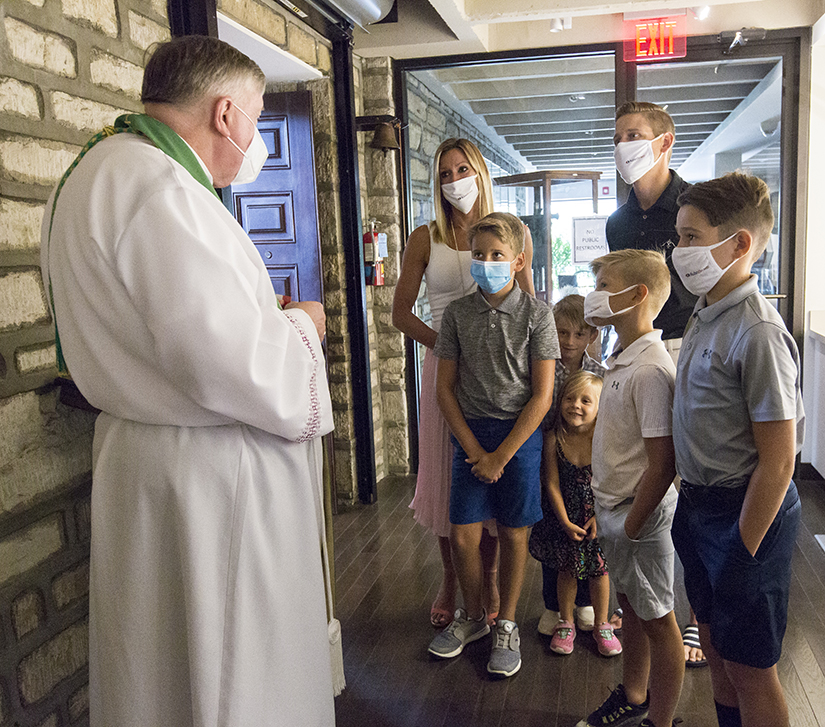 Archbishop Mitchell Rozanski spoke with Jessica and Jeff Sackman and their children, from left, Noah, 10, Declan, 6, Vivienne, 3, Dominic, 8, and Nicholas, 10, after Mass at the Basilica of St. Louis, King of France Aug. 30.Photo Credit: Lisa Johnston
Archbishop Mitchell Rozanski spoke with Jessica and Jeff Sackman and their children, from left, Noah, 10, Declan, 6, Vivienne, 3, Dominic, 8, and Nicholas, 10, after Mass at the Basilica of St. Louis, King of France Aug. 30.Photo Credit: Lisa JohnstonArchbishop Rozanski said he looks forward to getting to know the people of the archdiocese, including the many priests, deacons, women and men religious and laypeople. He said the people of the archdiocese should expect to see him spending much of his time learning about the Archdiocese of St. Louis.
“I need to be out amongst the people meeting them,” he said. “My first months here will be a lot of learning. I don’t want to make any decisions or have any preconceived notions” right away. “It’s a very relational time, because people share their thoughts and their feelings, their insights with me. I am looking forward to that.”
Archbishop Rozanski said that while it’s important to learn and to understand the faith, what the world needs, even more, are witnesses to the faith.
“The real challenge is taking the knowledge that is imparted, but connecting that knowledge with real life,” he said. “How is our faith lived out each and every day? A person who really lives the Gospel is a witness for others.”
In Pope Paul VI’s apostolic exhortation, “Evangelii Nuntiandi,” Archbishop Rozanski said, the Holy Father wrote “The world needs teachers of the faith, but even more so needs witnesses to the faith. The greatest formators are those who really live the faith.”
On the future of the Church
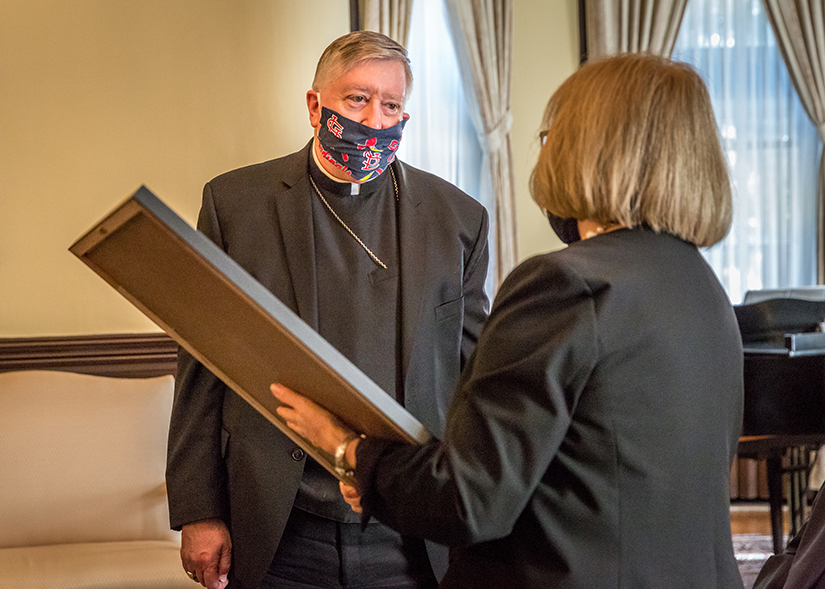 St. Louis mayor Lyda Krewson presented a proclamation to Archbishop Mitchell Rozanski on Aug. 21 at the Archbishop’s Residence. Photo Credit: Lisa Johnston
St. Louis mayor Lyda Krewson presented a proclamation to Archbishop Mitchell Rozanski on Aug. 21 at the Archbishop’s Residence. Photo Credit: Lisa JohnstonMany dioceses across the country continue to face a decline in the number of Catholics and a decrease in Catholic school enrollment. Archbishop Rozanski was no stranger to that, as he guided the merger of two Catholic high schools in the Diocese of Springfield during his tenure there.
As dioceses contemplate their future, Archbishop Rozanski said, Catholics must be willing to look beyond themselves and outward toward the Trinity — God, His Son Jesus and the Holy Spirit. That’s the inspiration we need, particularly when it comes to making painful decisions about the future of parishes and schools.
“We’re attached because for many people, some very meaningful occurrences of their lives have happened there,” he said. “Perhaps their grandparents were buried from that church, or they were baptized in that church, or married there.”
We need to acknowledge that our society is more mobile now than it had been 50 or 60 years ago, he said, and the Church isn’t impervious to those changes. “We have to remember where the true message is and what God is calling us to do and to be as His people,” he said. “It is being together as the Church that truly matters. It might not be the way it was when we were children or young adults. But circumstances change, and that’s why the Church has been around for 2,000 years — because it has adapted to different circumstances.”
Archbishop Rozanski’s biography
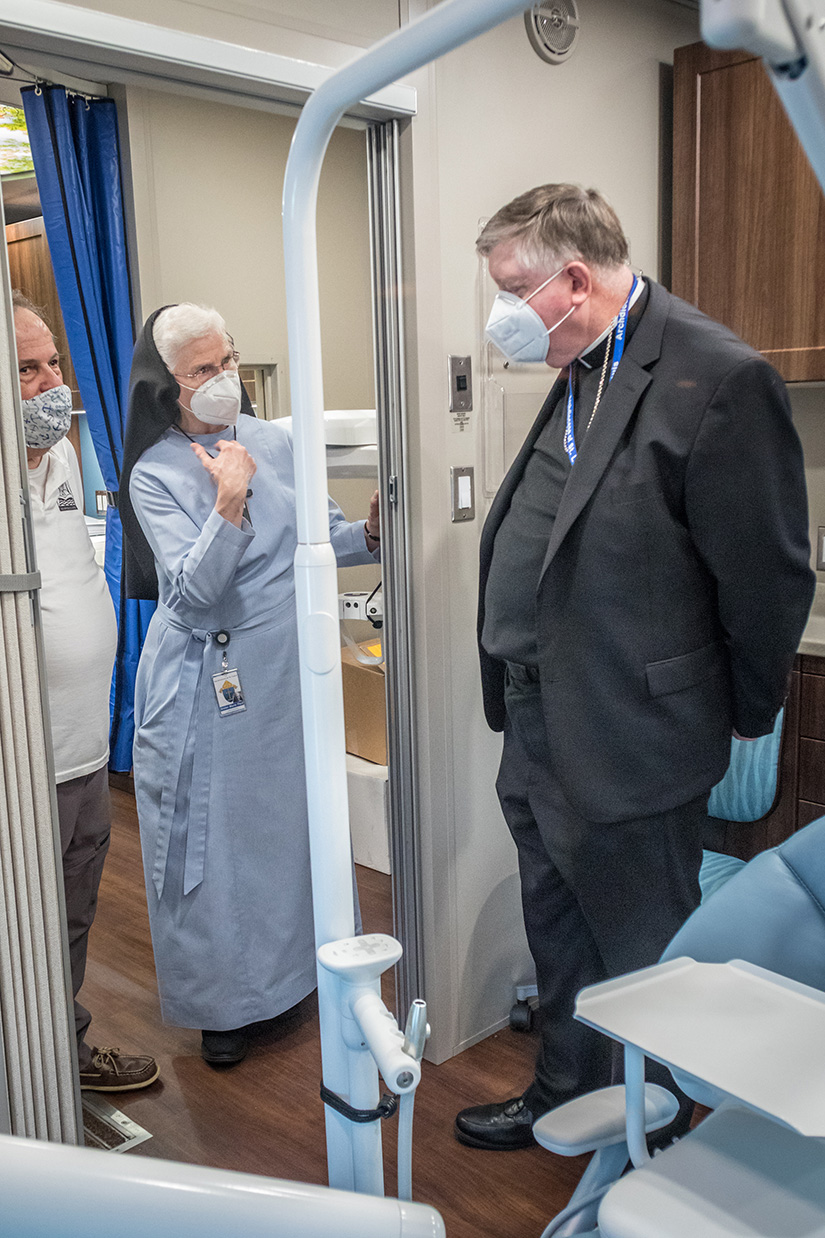 Archbishop Rozanski toured the new Rural Parish Clinic-
Dental unit with Sister Marie Paul Lockerd, RSM, DO, at the Cardinal Rigali Center on Sept. 11.Photo Credit: Lisa JohnstonArchbishop Mitchell Thomas Rozanski
Archbishop Rozanski toured the new Rural Parish Clinic-
Dental unit with Sister Marie Paul Lockerd, RSM, DO, at the Cardinal Rigali Center on Sept. 11.Photo Credit: Lisa JohnstonArchbishop Mitchell Thomas Rozanski
• Born in Baltimore, Maryland, on Aug. 6, 1958
• Lived in Fells Point, Maryland, and attended Holy Rosary Parish
• Parents, Alfred and Jean Rozanski, both still living
• His brother Kenneth and his wife Lisa have two daughters and a son
• His youngest brother Albert and his wife Danielle have one son
• At age 8, the family moved to Dundalk and the parish of the Sacred Heart of Mary, Graceland Park, where he attended the elementary school
• Graduated from Our Lady of Mt. Carmel High School in Essex, Maryland
• Received undergraduate degree from the Catholic University of America
• Entered the Theological College at the Catholic University of America for seminary training
• Ordained a priest of the Archdiocese of Baltimore at the Cathedral of Mary Our Queen on Nov. 24, 1984
Assignments:
• Associate pastor at St. Michael Parish in Overlea in 1984
• Associate pastor at Cathedral of Mary Our Queen in 1984
• Associate pastor at St. Anthony of Padua Parish in Baltimore in 1985
• Associate pastor at St. Isaac Jogues Parish in Baltimore in 1990
• Administrator then pastor of Holy Cross and St. Mary Star of the Sea parishes in Baltimore in 1993
• Administrator then pastor of Immaculate Conception Parish in Towson in 2000, then later that year assumed same duties at St. John Parish
• Named by Pope John Paul II as auxiliary Bishop for the Archdiocese of Baltimore on July 3, 2004
• Ordained a bishop on August 24, 2004, at the Cathedral of Mary Our Queen and named vicar general and episcopal vicar for the Seton Vicariate of the archdiocese. He also served on the College of Consultors for the Archdiocese and as the Vicar for Hispanics for the archdiocese
• Appointed bishop of Diocese of Springfield, Massachusetts, on June 19, 2014, by Pope Francis
• Installed on Aug. 12, 2014
• Named as 10th archbishop for the Archdiocese of St. Louis on June 10, 2020, by Pope Francis
• Installed on Aug. 25, 2020
Other service
Archbishop Rozanski has served as the Roman Catholic co-chair of the Polish National Catholic/Roman Catholic Dialogue since November 2017. Since Oct. 1, 2012, he has served as the episcopal moderator of the National Association of Holy Name Societies. He also serves on the Advisory Council of the National Association of Catholic Chaplains, and the National Catholic Partnership on Disability.He served on the National Committee for the Protection of Youth and Young People from January 2007 until June 2014. From 2012 until March 2015, Archbishop Rozanski served on the National Advisory Council of the United States Conference of Catholic Bishops (USCCB) for a three-year term. He also served on and chaired the Ecumenical and Interreligious Affairs Committee of the USCCB. Archbishop Rozanski is a member of the Fourth Degree Knights of Columbus, a Knight Commander of the Equestrian Order of the Holy Sepulchre of Jerusalem, Northeast Lieutenancy.
The pallium
During the installation Mass Aug. 25, Archbishop Rozanski was presented with the pallium, a woolen band that the heads of archdioceses wear around their shoulders over their Mass vestments. It is given to an archbishop by the pope as a sign of their unity with him as they minister to a part of the Catholic “flock.” This is the first time an archbishop of St. Louis has received the pallium in St. Louis.
The pallium measures about 3 inches wide and has a 14-inch strip hanging down the front and the back. The strips are finished with black silk, almost like the hooves of the sheep the archbishop is symbolically carrying over his shoulders.
The coat of arms
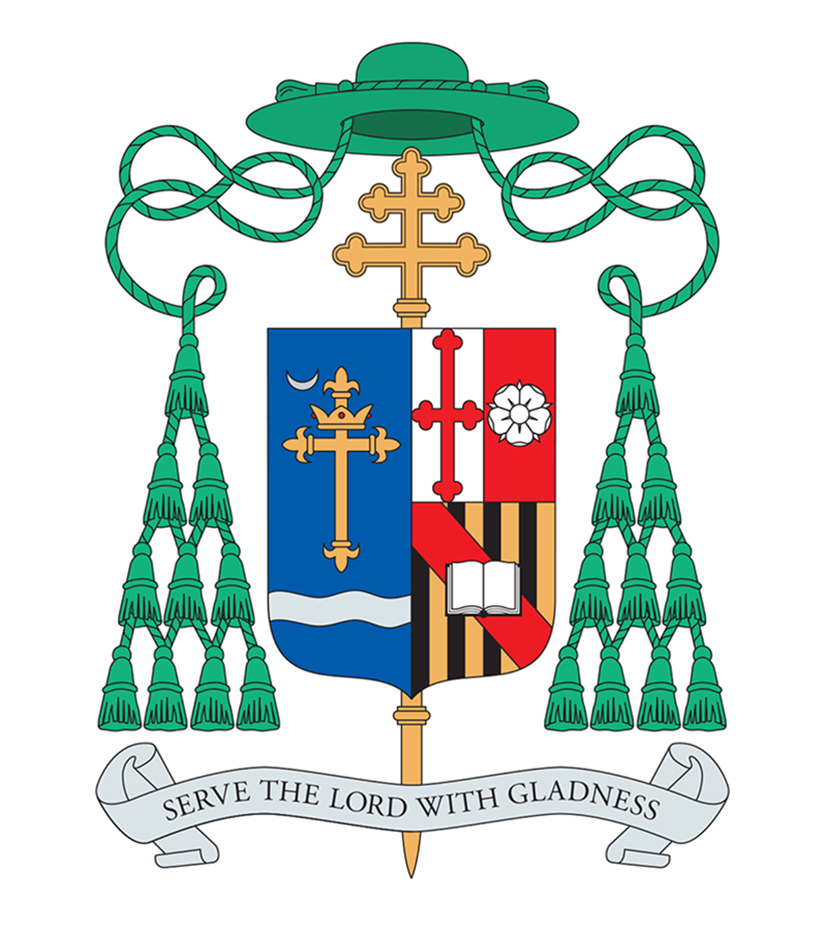 Archbishop Rozanski's coat of armsWhen an archbishop is appointed to lead an archdiocese, the coat of arms is composed of several key elements. The episcopal heraldic achievement, or, as it is more commonly known, the archbishop’s coat of arms, is composed of a shield with its charges (symbols) and the external ornaments. The shield, which is the central and most important feature of any heraldic device, is described (blazoned) in 12th century terms that are archaic to our modern language, and this description is done as if being given by the bearer with the shield being worn on the arm. From the viewpoint of the one behind the armor, the sides, or impalements, of the shield are labeled dexter (right) and sinister (left). The next element of the coat of arms is the archbishop’s motto, which is traditionally written.
Archbishop Rozanski's coat of armsWhen an archbishop is appointed to lead an archdiocese, the coat of arms is composed of several key elements. The episcopal heraldic achievement, or, as it is more commonly known, the archbishop’s coat of arms, is composed of a shield with its charges (symbols) and the external ornaments. The shield, which is the central and most important feature of any heraldic device, is described (blazoned) in 12th century terms that are archaic to our modern language, and this description is done as if being given by the bearer with the shield being worn on the arm. From the viewpoint of the one behind the armor, the sides, or impalements, of the shield are labeled dexter (right) and sinister (left). The next element of the coat of arms is the archbishop’s motto, which is traditionally written.
The great seal of the Archdiocese of St. Louis (left side) is an azure blue field with a gold crusader’s cross, and a crown representing St. Louis IX, King of France, patron of both the Archdiocese of St. Louis and City of St. Louis. On the extremes of the cross are found the fleur-de-lis flower that recalls the French foundation of the city.
For his personal arms, Archbishop Rozanski has selected a design that is based on two major themes; his Polish heritage and his service to the Archdiocese of Baltimore. In the upper portion of the design, in red and silver (white), the colors of the Polish national flag, are a cross bottony (each arm terminates in a triple ball), which represented in red on silver is a variant on the symbolism known as a “cross of St. Michael,” the archbishop’s baptismal patron. To the right of the cross (chief dexter) is a silver rose on a red field, drawing upon the significance that Archbishop Rozanski’s family name refers to “Rose flower” in Polish.
In the base, on the alternating vertical bars of black and gold (yellow) with a red diagonal bar called a “bend,” is an open book of the Most Holy Scriptures. These charges, drawn from the arms of the Archdiocese of Baltimore, signify that His Excellency’s ministry as a deacon, priest and now as an archbishop is to spread God’s Holy Word to the faithful of the archdiocese. This symbolism joins well with the archbishop’s motto, which is taken from Psalm 100, that in all that Archbishop Rozanski is to do for the Lord, he is called to “Serve the Lord With Gladness.”
The device is completed with the external ornaments that are a gold processional cross, which is placed in back of the shield and which extends above and below the shield, and a pontifical hat, called a “gallero,” with its 10 tassels, in four rows, on either side of the shield, all in green. These are the heraldic insignia of a prelate of the rank of archbishop by instruction of the Holy See of March 31, 1969.
Having the heart of a parish priest and serving the Lord with gladness aptly describe Archbishop Mitchell Rozanski.
At his Mass of Installation Aug. 25 at the Cathedral Basilica of Saint Louis, Archbishop Rozanski told the people of the Archdiocese of St. Louis, “As a Catholic, even more as a pastor, I pledge my own fidelity, and unity and that of God’s people in this ‘Rome of the West’ to Peter’s successor among us, without whom we cannot know the Lord who sent him, the Lord who seeks to send us.”
St. Louis’ 10th archbishop served the Church in the Eastern United States for 36 years. Ordained a priest for the Archdiocese of Baltimore in 1984, he served in parishes for 20 years. He was ordained a bishop in 2004 and served as an auxiliary bishop in Baltimore for the next decade. He became the Bishop of Springfield, Massachusetts, in 2014
Being a parish priest brought its challenges and joys, but what was important was building relationships and maintaining communication with the people he served, he said. As a bishop, he sees himself still having the heart of a parish priest, but now his parish territory is a little bit larger.
“Parish priests are graced to be with people in such moments of their lives — weddings, baptisms, funerals — and that really establishes a relationship,” Archbishop Rozanski said. “I miss those relationships I had as a parish priest … but it’s also taught me that being a bishop does not mean being removed from that sort of interaction of ministry, of being involved in the lives of people and reaching out.”
Archbishop Rozanski’s episcopal motto, “Serve the Lord with Gladness,” comes from Psalm 100. He wanted something with an action word that would serve as a reminder of living the faith in concrete ways.
“If we do live our faith concretely in serving the Lord, then we will certainly have hearts that are joyful,” he said. “It means that if we put our faith into action, and we live the Lord’s words, then we’re joyful.”
The early inhabitants of St. Louis were a people of hope, who came to this area in search of a better life and a place to raise their families, he said. That kind of hope is needed in our world today. Citing urgent crosses facing our nation and Church today, including the COVID-19 pandemic, systemic racism and civil discourse, Archbishop Rozanski said we need to ask ourselves where God is in all of this. “We need only to look at the words of Jesus in today’s Gospel: ‘Love one another as I have loved you.’
“In the midst of a pandemic, a societal reckoning on the life issue of race relations, an atrophied civic discourse — and yes, the often-sinful polemics we now face within our Church — loving one another seems to be a tough thing to do these days. Yet, my friends, we are called to be a people of hope.
“This ‘Gateway City’ provides us a rich imagery — for in order for us to live out this fundamental command to love one another it must be carried out in action. We ourselves must be gateways, not gatekeepers; gateways to healing, to evangelization, to mercy, to compassion — gateways to listening with the ears of Jesus.”
Getting to know the new archbishop
Archbishop Rozanski said he looks forward to getting to know the people of the archdiocese, including the many priests, deacons, women and men religious and laypeople. He said the people of the archdiocese should expect to see him spending much of his time learning about the Archdiocese of St. Louis.
“I need to be out amongst the people meeting them,” he said. “My first months here will be a lot of learning. I don’t want to make any decisions or have any preconceived notions” right away. “It’s a very relational time, because people share their thoughts and their feelings, their insights with me. I am looking forward to that.”
Archbishop Rozanski said that while it’s important to learn and to understand the faith, what the world needs, even more, are witnesses to the faith.
“The real challenge is taking the knowledge that is imparted, but connecting that knowledge with real life,” he said. “How is our faith lived out each and every day? A person who really lives the Gospel is a witness for others.”
In Pope St. Paul VI’s apostolic exhortation “Evangelii Nuntiandi,” Archbishop Rozanski said, the Holy Father wrote “The world needs teachers of the faith, but even more so needs witnesses to the faith. The greatest formators are those who really live the faith.”
On the future of the Church
Many dioceses across the country continue to face a decline in the number of Catholics and a decrease in Catholic school enrollment. Archbishop Rozanski was no stranger to that, as he guided the merger of two Catholic high schools in the Diocese of Springfield during his tenure there.
As dioceses contemplate their future, Archbishop Rozanski said, Catholics must be willing to look beyond themselves and outward toward the Trinity — God, His Son Jesus and the Holy Spirit. That’s the inspiration we need, particularly when it comes to making painful decisions about the future of parishes and schools.
“We’re attached because for many people, some very meaningful occurrences of their lives have happened there,” he said. “Perhaps their grandparents were buried from that church, or they were baptized in that church, or married there.”
We need to acknowledge that our society is more mobile now than it had been 50 or 60 years ago, he said, and the Church isn’t impervious to those changes. “We have to remember where the true message is and what God is calling us to do and to be as His people,” he said. “It is being together as the Church that truly matters. It might not be the way it was when we were children or young adults. But circumstances change, and that’s why the Church has been around for 2,000 years — because it has adapted to different circumstances.”